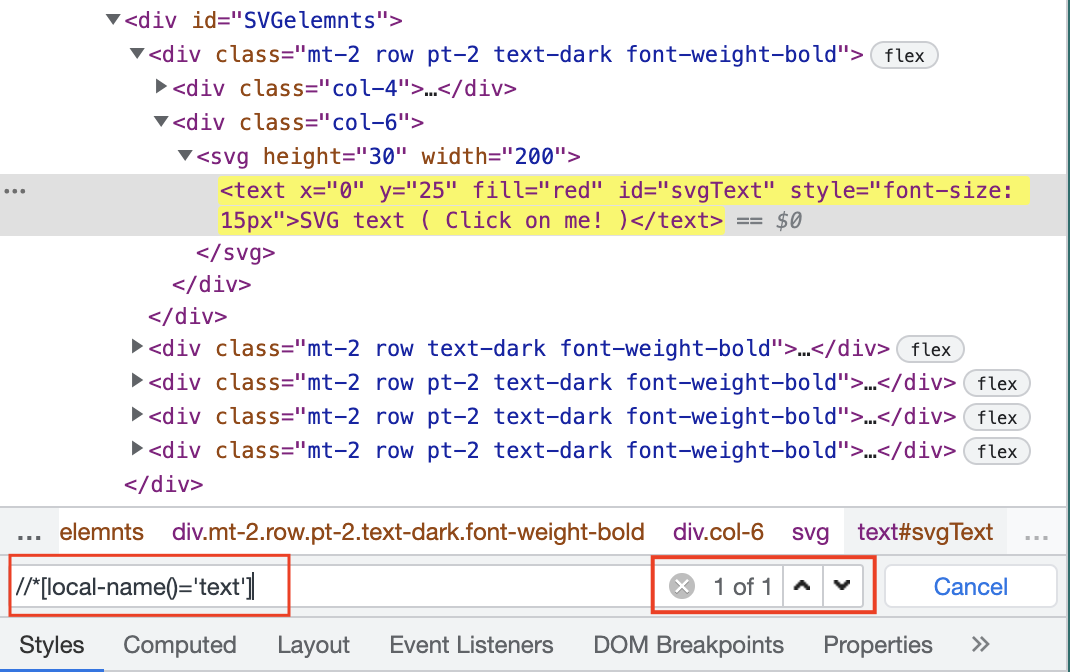Earlier, we had discussed how to find an SVG element using XPath, and this post will look at clicking on the SVG element in Selenium using Java.
We will click on the below-highlighted SVG element on the URL: https://testkru.com/Elements/SVGelemnts.

There are a couple of ways to click on SVG elements, and we will discuss them in this post and talk about which one should be preferred between them.
- Using WebElement.click()
- and by using Actions.click()
WebElement.click()
WebElement click() method is one of the most common ways in Selenium to click on various elements. We will use it to click on our SVG element.
We can find the above-highlighted element using the “//*[local-name()='text']” Xpath and then click on it using the click() method.
WebElement webElement = driver.findElement(By.xpath("//*[local-name()='text']"));
webElement.click();
1 2 3 4 5 6 7 8 9 10 11 12 13 14 15 16 17 18 19 20 21 22 23 24 25 26 | import org.openqa.selenium.By;import org.openqa.selenium.WebDriver;import org.openqa.selenium.WebElement;import org.openqa.selenium.chrome.ChromeDriver;public class CodekruTest { public static void main(String[] args) { // pass the path of the chromedriver location in the second argument System.setProperty("webdriver.chrome.driver", "E:\\chromedriver.exe"); WebDriver driver = new ChromeDriver(); // finding the SVG element WebElement webElement = driver.findElement(By.xpath("//*[local-name()='text']")); // clicking on SVG element webElement.click(); System.out.println("Text after clicking: " + webElement.getText()); }} |
Output –
Text after clicking: Clicked!Actions.click()
Another way of clicking on an SVG element is using the click() method provided by the Actions class.
1 2 3 4 5 6 | // finding the SVG elementWebElement webElement = driver.findElement(By.xpath("//*[local-name()='text']"));// clicking on SVG elementActions actions = new Actions(driver);actions.moveToElement(webElement).click().build().perform(); |
Finding the element remains the same. We are just now clicking the element using the click() method of the Actions class.
1 2 3 4 5 6 7 8 9 10 11 12 13 14 15 16 17 18 19 20 21 22 23 24 25 26 27 28 | import org.openqa.selenium.By;import org.openqa.selenium.WebDriver;import org.openqa.selenium.WebElement;import org.openqa.selenium.chrome.ChromeDriver;import org.openqa.selenium.interactions.Actions;public class CodekruTest { public static void main(String[] args) { // pass the path of the chromedriver location in the second argument System.setProperty("webdriver.chrome.driver", "E:\\chromedriver.exe"); WebDriver driver = new ChromeDriver(); // finding the SVG element WebElement webElement = driver.findElement(By.xpath("//*[local-name()='text']")); // clicking on SVG element Actions actions = new Actions(driver); actions.moveToElement(webElement).click().build().perform(); System.out.println("Text after clicking: " + webElement.getText()); }} |
Output –
Text after clicking: Clicked!WebElement.click() vs Actions.click(), which one should be preferred to click on the SVG element?
It is recommended to use Actions.click() instead of WebElement.click() when clicking on an SVG element because SVG elements can have non-rectangular shapes, simply clicking on the centre of the element’s bounding box may not always result in the desired behaviour.
And Actions.click() method also provides a way to click on a specified location. Thus it becomes easy to click on elements with complex shapes.
We hope that you have liked the article. If you have any doubts or concerns, please write to us in the comments or mail us at admin@codekru.com.
